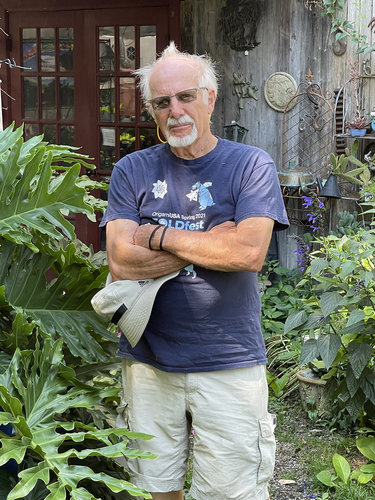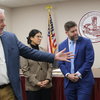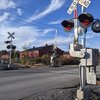Picard Road resident looks to share his rural route with more than just motorists
NEW SCOTLAND — Paul Steinkamp says that, since the advent of the automobile, drivers have thought they shouldn’t have to share the road with anyone else, be they cyclists, pedestrians, or otherwise.
It’s why he’s worked over the past year — the timing is out of his hands — on a very modest proposal: the installation of two signs on Picard Road, notifying motorists to share the road.
On Monday, he met with success.
Picard Road runs along the base of the Helderberg escarpment and much of the land along the road is protected from development by conservation easements, part of a 3,700-acre corridor, stretching from the Black Creek Marsh to John Boyd Thacher State Park.
Steinkamp said he recently noticed something near the intersection of Picard and Tygert roads. “Painted on the pavement at Tygert is this little white … “picture of a bicycle” over the phrase “in lane.” He said, “That is not what I’m interested in. I want people driving down the road to realize that other people are using the road.”
Steinkamp and his wife, Mardell, have owned the 40-acre property for about 45 years. The Steinkamp home and nursery operation sit slightly above and just back from Picard Road — a county-owned road — offering him unfettered views of cars, trucks, and motorcycles speeding along the roadway, which Steinkamp says is a route that also sees a lot of foot and bike traffic.
“This road is very strange,” he said of Picard Road, also known as County Route 307, as it offers the only access to what Steinkamp called “the upper mountain,” where County Route 157 enters Thatcher Park from the south, and the village Altamont.
“So you’ve got this sort of dam of circulation, right? So everybody comes by here,” he said; a lot of drivers use Picard Road as “shortcut or an avoidance,” he added, surmising it’s used as a backway to New York State Route 32 in Clarksville.
Steinkamp said the inherent beauty of area — with the road being bound on either side by the Black Swamp and Heldeberg Workshop — makes just driving along Route 307 a pleasant experience, “meaning there are a lot of people who drive the road just because it’s a nice road to be on.”
But the road’s pastoral setting also attracts pedestrians, bicyclists, dog walkers, and a high school track team, which can become an issue because of its curves and up-and-down speed limits. In certain places, Picard Road has a 45 mile-per-hour speed limit while in other parts it’s 35.
And speeding has only gotten worse since the route was repaved two years ago, which had been predicted by someone from Albany County at the time, Steinkamp said.
The county’s highway department is “very driver conscious,” said Steinkamp in a slightly wry observation. “They’re interested in moving automobiles; they have that mentality.” Bicyclists and pedestrians are seen only as nuisances, he said, “cars are what they are interested in.”
He noted in surrounding communities, pointing specifically to Guilderland for his example, “You get on a country road like this and it’s 30 miles an hour, and I always go 30 miles an hour.” In the 45 years he’s lived on Picard Road, Steinkamp said, he’s only ever seen someone stopped once for speeding.
Steinkamp said he isn’t looking for much: He’d like to see some signs with a bicyclist and the phrase “share,” or “share the road.” He admitted, “The sign means nothing, it’s probably not going to do anything” but he wants “bicyclists to realize somebody’s thinking about them.”
Steinkamp said recently he spoke with someone from the state about painting green the white line running along the edge of Picard Road, which in traffic-engineering terms is known as an “edge line pavement marking.”
When asked why he spoke with someone from the state about a county road, Steinkamp said because there can be conflicting local, state, and federal programs.
As for what he called his “green road” idea, Steinkamp said he came across it in plans from the city of Tucson in Arizona, which has an extensive and well-funded bicycle and pedestrian program.
“In addition, I think, to providing a bicycle lane, or designating certain streets as bicycle streets, they have a painted green stripe all the way along the bike route,” he said. Tucson’s street-design guide recommends, when different types of dedicated bike lanes are to be installed, that, for safety reasons, certain areas of pavement be entirely painted green or that the lane receive green “conflict markings.”
“And I thought, ‘Wasn’t that something? They told me it couldn’t be done.’ Well, it can be done. Anything can be done and anything can be tried,” Steinkamp said.
And it’s not just slapping some green paint on the pavement, he said, “There’s a whole collection of things that go along with this: how you drive your car when you go by a bicyclist, what happens to you at a crosswalk?”
In addition to what has happened in Tucson, Steinkamp said he is aware of the city of Albany’s recent bike plans.
In 2021, the city updated its decade-old bicycle and pedestrian master plan, and recommended the installation of over 90 miles of “bike facilities” that, depending on the amount of daily traffic, proposed various bike lanes, from a “protected lane,” which can use a curb or planter or parked car to create a barrier between cyclist and motorist, to conventional and buffered-space bike lanes.
“Wouldn’t it be good to have a rural one?” Steinkamp asked of a dedicated or designated bike lane on Picard Road. But after thinking about what would be nice, Steinkamp thought about what could be actually done on Picard Road just to make people more aware: Signs.
“Bike signs, deer signs, pedestrian signs, tractor signs, I asked for all of them,” he said, but was told two was the limit.
The request has now been with Albany County for a year.
In that time, he’s called and gone in person to try to get some kind of update. Nothing. But Steinkamp’s perseverance appears to finally be paying off.
“So they are doing something because they painted that thing on the road: bikes in lane,” he said, and he’s also been told by others at the county about his sign request: “It’s in the bag.”
The Enterprise spoke with Steinkamp on Aug. 26, and contacted Albany County on Aug. 29 for comment about a timeline for installing the signs. Prior to a response from the county, Steinkamp told the paper that workers were placing three signs along Picard Road, at its intersections with Route 156, Tygert Road, and Route 85A.



